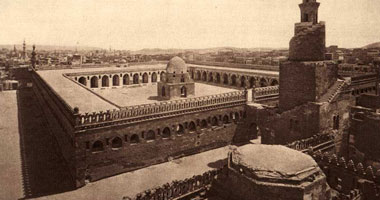Ahmed Ibn Tulun is the founder of the Tulunid state in Egypt, which ruled for 36 years from 868 to 904 AD. The Abbasid Caliph sent him as ruler of Egypt, and Ibn Tulun declared himself an independent ruler.
Ahmed bin Tulun built the city of Qata’i; To be the capital of him and his rule in Egypt throughout the Tulunid era, and he built a large palace with a field for playing wands. He also established a stable to breed horses, and took care of a number of them, and his son Khamarawih succeeded him in ruling, who was also interested in horses and their upbringing.
And the sport of mace became one of the most important sports that received the attention and care of the ruler himself. The princes were divided into two groups: a team with the sultan, and a team with the prince of princes, and with their hands the goats. The Sultan begins to hit the ball, then the individuals take it after him, and during the game the drums are beating. After they finish playing, they are offered a drink and a fatty.

There was great interest in racing during the Khamarawih era. On the day of the race, decorations were attached to it, such as holidays, and the race became a large audience, and at that time the saying of the four wonders of Islam (horse show in Egypt, Ramadan in Mecca, Eid Peters, and Friday in Baghdad) spread.
Khamarawih also created records to record the genealogy of horses, and he was keen to mention all the details and acquire the most beautiful and strongest of them.
The Fatimids bring back the glories of the Pharaohs in horses
The period of the rule of the Ikhshidid state in Egypt, which amounted to 34 years, did not witness a decent interest in horses, as happened in the era of its predecessor, the Tulunid state, although Muhammad bin Tughaj al-Ikhshid established a field for royal horses in his orchard, which was known as the “Kafuri orchard”. While the Fatimids succeeded in competing with the Pharaohs in their interest in horses, until it was a truly golden age.
The Fatimids ruled Egypt for 98 years, from 969 until 1171 AD, during which horses found great interest and competition. The Fatimid state was interested in celebrations and feasts. The leader, Jawhar al-Siqilli, built for the Caliph al-Muizz Lidin Allah the Fatimid a palace known as the “Great Eastern Palace”, and he built another small palace for Ibn al-Muizz. In the name of “Small Western Palace”, and he built a stable next to the Eastern Palace known as “Al Tarma Stable”, and next to the Western Palace he built another stable known as “Gemuzeh”, and it was called by this name due to its presence in the middle of a large sycamore, and a large area of alfalfa was planted for the caliph’s horses.
2000 horses in the Caliph stables
Ali Mubarak says that the stable of Al-Tarmeh is the stable of the palace, and that its place is now Al-Shanawani Street and its buildings and alleys. Abu al-Abbas al-Qalqashandi said in “Subh al-A’sha”: The private stables had about two thousand heads of horses for the private caliph’s rides or for processions and grants.
It was not heard from the Fatimids that they possessed the most admirable horses, and the horses were divided into great stables, and each stable had a director called “Ra’id al-Istabil”, which is what was called in the Turkish state an emperor, and there were many climates for many camels.
Horses and knights adorn the Fatimid ceremonies
The Fatimid Caliph used to go out on holidays in formal clothes, and horses, knights and entourage were decorated.
The documents and sources stated that for every horse there were two young men who led it in the processions, and for every three horses a sire, and a sire was supervising every 20 horses, and there was a general supervisor of the stable named “Raid”. Each stable was attached to a well, a waterwheel and barley stores, and the horses were served by the women of the caliph, and this custom continued in the Mamluk era.
The Ayyubids… Interest in horses diminishes at the end of their state
The Ayyubid state ruled Egypt for 79 years from 1171 to 1250 AD, and at the beginning of its era was interested in horses and the establishment of their own stables, but at the end of the era of Saleh Najm al-Din Ayyub, the care of horses eased.
Although there is not enough information about horses, we conclude that the Ayyubid state was interested in the system of Prince Khor, which was followed by the Fatimids in managing the stable. This is clear from the continuation of this system in the era of the Mamluks.
The Citadel of Salah al-Din had many stables of princes. This is evidence that the system has been in place since the time of the Ayyubids.
The writer Muhammad Farid Abu Hadid talks about Salah al-Din al-Ayyubi in his book “Salah al-Din and his era”, where he described him as the founder of a great Egyptian state whose Egyptianness is not suspicious. The countries that preceded them were not purely Egyptian; This is because the state of the Tulunids and Ikhshidids was not in the correct sense, rather it was primary, and the Fatimid state in Egypt was not national in the full sense.
It is known that the Ayyubid state entered many battles and wars, and the East achieved victory over the West by Salah al-Din in that huge struggle that shook the world, a struggle known as the Crusades. It is known that fights need good, strong horses.






